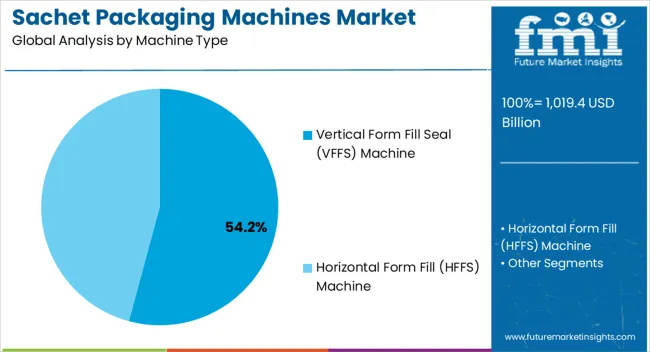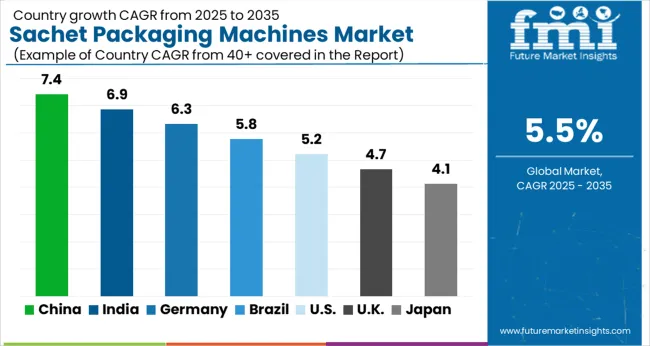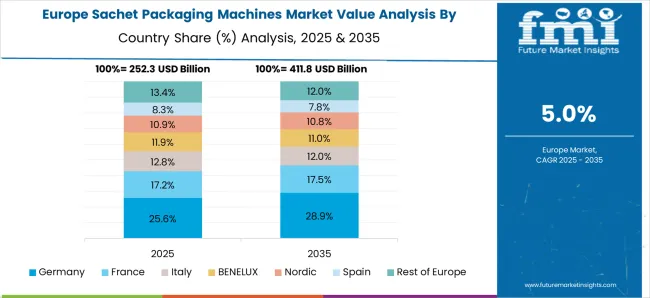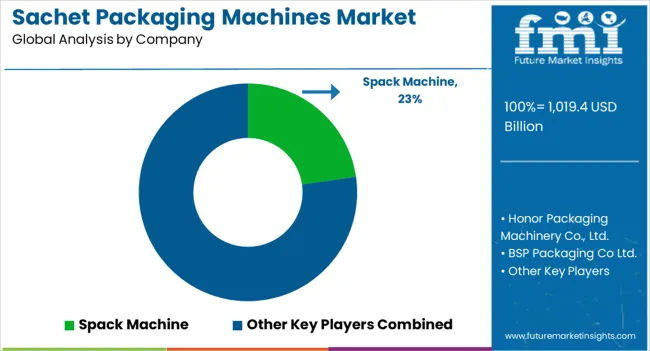The global sachet packaging machines market is valued at USD 4.2 billion in 2025 and is slated to reach USD 6.8 billion by 2035, recording an absolute increase of USD 2.6 billion over the forecast period. This translates into a total growth of 61.9%, with the market forecast to expand at a CAGR of 4.9% between 2025 and 2035.
The market size is expected to grow by approximately 1.62X during the same period, supported by increasing demand for portion control packaging, expanding food and beverage industry applications, and rising adoption of automated packaging solutions across pharmaceutical, cosmetics, and consumer goods sectors.
Between 2025 and 2030, the sachet packaging machines market is projected to expand from USD 4.2 billion to USD 5.3 billion, resulting in a value increase of USD 1.1 billion, which represents 42.3% of the total forecast growth for the decade.
This phase of development will be shaped by increasing demand for single-serve packaging solutions, rising adoption of high-speed automated packaging systems, and growing requirements for flexible packaging formats across pharmaceutical and food processing industries. Packaging equipment manufacturers are expanding their sachet machine production capabilities to address the growing demand for precision dosing, multi-lane packaging systems, and enhanced sealing technologies.
| Metric | Value |
|---|---|
| Estimated Value in (2025E) | USD 4.2 billion |
| Forecast Value in (2035F) | USD 6.8 billion |
| Forecast CAGR (2025 to 2035) | 4.9% |
From 2030 to 2035, the market is forecast to grow from USD 5.3 billion to USD 6.8 billion, adding another USD 1.5 billion, which constitutes 57.7% of the ten-year expansion. This period is expected to be characterized by the integration of advanced automation technologies, the adoption of Industry 4.0 solutions with IoT connectivity, and the development of machines with enhanced flexibility for multiple product formats. The growing demand for smart packaging solutions will drive requirements for sachet machines with real-time monitoring capabilities, predictive maintenance features, and integration with enterprise resource planning systems across manufacturing operations.
Between 2020 and 2025, the sachet packaging machines market experienced robust growth, driven by increasing consumer preference for portion-controlled packaging and growing recognition of sachet packaging as cost-effective solutions for product sampling, travel-size products, and single-use applications. The market developed as manufacturers across pharmaceutical, food, and personal care industries recognized the potential for sachet packaging to provide superior product protection while enabling efficient distribution and reduced packaging costs. Technological advancement in servo-driven systems and precision filling technologies began emphasizing the critical importance of maintaining packaging accuracy and production speed in high-volume manufacturing environments.
Market expansion is being supported by the increasing demand for convenient packaging formats and the corresponding need for packaging systems that can provide precise dosing, high-speed production, and flexible format capabilities while enabling cost-effective packaging solutions and supporting product differentiation across pharmaceutical, food and beverage, cosmetics, and consumer goods manufacturing operations. Modern manufacturers are increasingly focused on implementing packaging solutions that can improve production efficiency, reduce material waste, and provide consistent quality throughout complex multi-product packaging lines. Sachet packaging machines' proven ability to deliver exceptional precision, enable high-speed operation, and support diverse product formats make them essential equipment for contemporary packaging infrastructure and manufacturing operations.
The growing emphasis on product sampling and trial-size packaging is driving demand for sachet packaging machines that can support small-batch production requirements, improve market penetration strategies, and enable efficient promotional campaigns. Manufacturers' preference for machines that combine speed with format flexibility and processing versatility is creating opportunities for innovative sachet packaging implementations. The rising influence of e-commerce growth and direct-to-consumer distribution models is also contributing to increased demand for sachet packaging machines that can provide tamper-evident sealing, attractive presentation, and integration with automated fulfillment systems across diverse operational scenarios.
The sachet packaging machines market is poised for robust growth and evolution. As pharmaceutical companies, food processors, and consumer goods manufacturers seek machines that deliver exceptional precision, high-speed operation, and format versatility, sachet packaging machines are gaining prominence not just as packaging equipment but as strategic enablers of efficient production systems and market expansion.
Rising demand for portion control packaging in developing regions and expanding pharmaceutical manufacturing globally amplify requirements, while manufacturers are leveraging innovations in servo technology, smart monitoring systems, and multi-lane production capabilities.
Pathways like smart machine integration, eco-friendly packaging materials, and application-specific configuration options promise strong adoption rates, especially in high-growth segments. Geographic expansion and pharmaceutical partnership development will capture volume, particularly where local manufacturing capabilities and regulatory compliance proximity are critical. Industry pressures around packaging efficiency standards, product safety requirements, serialization mandates, and quality compliance give structural support.
The market is segmented by machine type, filling mechanism, end-use industry, sales channel, and region. By machine type, the market is divided into Vertical Form Fill Seal (VFFS), Horizontal Form Fill Seal (HFFS), and Pre-made Pouch Machines. By filling mechanism, it covers volumetric filling, auger filling, liquid pumps, and multi-head weighers. By sales channel, it includes direct sales, distributors, and online channels. By end-use industry, it is categorized into pharmaceutical, food and beverage, personal care and cosmetics, chemicals, and others. Regionally, the market is divided into North America, Europe, East Asia, South Asia & Pacific, Latin America, and the Middle East & Africa.

The Vertical Form Fill Seal (VFFS) segment is projected to account for 54.2% of the sachet packaging machines market in 2025, reaffirming its position as the dominant machine category. Pharmaceutical and food manufacturers increasingly utilize VFFS sachet machines for their optimal combination of production speed, format flexibility, and sealing reliability characteristics, making them ideal for high-volume single-serve packaging applications. The VFFS technology's established industry acceptance and proven performance directly address the operational requirements for consistent packaging quality in diverse product formulations and production environments.
This machine segment forms the foundation of modern packaging operations, as it represents the technology with the greatest market penetration and established demand across pharmaceutical, food processing, and consumer goods applications. Manufacturer investments in advanced servo control systems and precision filling mechanisms continue to strengthen adoption among packaging companies and contract manufacturers. With organizations prioritizing production efficiency and format versatility, VFFS sachet machines align with both performance requirements and operational flexibility, making them the central component of comprehensive packaging strategies.

Direct sales from manufacturers are projected to represent 72.1% of sachet packaging machines distribution in 2025, underscoring their critical role as the primary channel for delivering machines to pharmaceutical companies, food processors, and large-scale manufacturing facilities through direct procurement relationships. Packaging equipment buyers prefer direct sales channels for their ability to provide customized solutions, comprehensive training programs, and direct technical support while ensuring machine specifications with manufacturer warranties. Positioned as essential procurement approaches for high-value equipment requirements, direct sales offer both technical advantages and service support benefits.
The segment is supported by continuous innovation in customer service programs and the growing availability of customized machine configurations that enable production optimization with enhanced automation features and integration capabilities. Manufacturers are establishing long-term service agreements to support consistent machine performance and operational support. As pharmaceutical regulations become more stringent and production requirements increase, direct sales channels will continue to dominate the distribution landscape while supporting comprehensive equipment supply and technical partnership strategies.
The sachet packaging machines market is advancing rapidly due to increasing demand for portion-controlled packaging and growing adoption of automated packaging solutions that provide precise dosing, high-speed operation, and format flexibility while enabling cost-effective packaging across pharmaceutical, food and beverage, and consumer goods applications. The market faces challenges, including high initial investment costs, competition from alternative packaging formats, and the need for skilled operators to manage complex automated systems. Innovation in smart monitoring technologies and flexible machine design continues to influence product development and market expansion patterns.
The growing adoption of IoT sensors, machine learning algorithms, and predictive maintenance systems is enabling manufacturers to produce sachet packaging machines with superior operational visibility, enhanced quality control, and data-driven optimization functionalities. Advanced monitoring systems provide improved production planning while allowing more efficient changeover scheduling and real-time performance tracking across various pharmaceutical operations and food processing facilities. Packaging equipment operators are increasingly recognizing the operational advantages of smart machine capabilities for production optimization and quality assurance.
Modern sachet packaging machine producers are incorporating servo-driven systems, automated changeover mechanisms, and integrated quality control programs to enhance production efficiency, enable rapid format changes, and deliver value-added solutions to productivity-focused pharmaceutical companies and food manufacturers. These automation innovations improve operational efficiency while enabling new market opportunities, including lights-out manufacturing, remote monitoring programs, and predictive maintenance. Advanced automation integration also allows manufacturers to support customer productivity goals and regulatory requirements beyond traditional packaging functionality.

| Country | CAGR (2025 to 2035) |
|---|---|
| China | 8.4% |
| India | 9.1% |
| USA | 4.2% |
| Germany | 3.8% |
| Brazil | 6.3% |
| United Kingdom | 4.1% |
| France | 3.9% |
The sachet packaging machines market is experiencing varied growth globally, with India leading at a 9.1% CAGR through 2035, driven by the expanding pharmaceutical manufacturing sector, growing food processing industry development, and significant investment in automated packaging systems. China follows at 8.4%, supported by rapid industrialization, increasing pharmaceutical exports, and growing demand for efficient packaging solutions. The USA shows growth at 4.2%, emphasizing advanced automation adoption and pharmaceutical innovation. Germany demonstrates 3.8% growth, prioritizing precision engineering excellence and advanced manufacturing technologies. Brazil records 6.3%, focusing on pharmaceutical sector expansion and growing food processing capabilities. The United Kingdom exhibits 4.1% growth, emphasizing pharmaceutical manufacturing and food safety compliance. France shows 3.9% growth, supported by pharmaceutical excellence and food industry modernization.
The report covers an in-depth analysis of 40+ countries, top-performing countries highlighted below.
Revenue from sachet packaging machines in India is projected to exhibit exceptional growth with a CAGR of 9.1% through 2035, driven by expanding pharmaceutical manufacturing sector and rapidly growing food processing industry supported by government initiatives promoting manufacturing excellence. The country's strong position in pharmaceutical exports and increasing investment in automated packaging systems are creating substantial demand for sachet packaging machine solutions. Major pharmaceutical companies and food processors are establishing comprehensive equipment procurement programs to serve both domestic production requirements and global export markets.
Demand for sachet packaging machines in China is expanding at a CAGR of 8.4%, supported by the country's massive manufacturing sector, expanding pharmaceutical industry, and increasing adoption of automated packaging technologies. The country's focus on manufacturing efficiency and growing export capabilities are driving requirements for comprehensive packaging machinery capabilities. International suppliers and domestic manufacturers are establishing extensive production and service capabilities to address the growing demand for sachet packaging machine products.

Revenue from sachet packaging machines in the USA is growing at a CAGR of 4.2%, supported by the country's advanced pharmaceutical industry, strong emphasis on production efficiency, and robust demand for automated packaging technologies in pharmaceutical and nutraceutical applications. The nation's mature manufacturing infrastructure and innovation-focused operations are driving sophisticated sachet packaging systems throughout the production network. Leading manufacturers and technology providers are investing extensively in smart features and advanced automation to serve both domestic and international markets.
Demand for sachet packaging machines in Germany is expected to expand at a CAGR of 3.8%, driven by the country's precision engineering capabilities, advanced manufacturing standards, and commitment to pharmaceutical excellence. Germany's technical expertise and quality focus are supporting demand for sachet packaging machines in pharmaceutical manufacturing, chemical processing, and high-end food applications. Manufacturers are establishing comprehensive engineering systems to serve the demanding domestic market and European export opportunities.
Revenue from sachet packaging machines in Brazil is anticipated to grow at a CAGR of 6.3%, supported by the country's growing pharmaceutical industry, expanding food processing sector, and increasing investment in manufacturing modernization. Brazil's large domestic market and commitment to pharmaceutical development are supporting demand for sachet packaging machine solutions across multiple industrial segments. Manufacturers are establishing comprehensive production capabilities to serve the growing domestic market and regional opportunities.
Demand for sachet packaging machines in the United Kingdom is expanding at a CAGR of 4.1%, driven by the country's established pharmaceutical industry, emphasis on regulatory compliance, and strong position in specialty manufacturing. The UK's advanced pharmaceutical capabilities and commitment to quality are supporting investment in modern packaging technologies throughout major pharmaceutical companies. Industry leaders are establishing comprehensive validation systems to serve pharmaceutical manufacturers and specialty chemical producers.
Revenue from sachet packaging machines in France is growing at a CAGR of 3.9%, supported by the country's pharmaceutical manufacturing excellence, growing food processing sector, and strategic position in European markets. France's established pharmaceutical companies and integrated manufacturing infrastructure are driving demand for quality sachet packaging machines in pharmaceutical production, food processing, and specialty chemical applications. Leading manufacturers are investing in specialized capabilities to serve pharmaceutical requirements and quality standards.

The sachet packaging machines market in Europe is projected to grow from USD 1.3 billion in 2025 to USD 1.9 billion by 2035, registering a CAGR of 3.8% over the forecast period. Germany is expected to maintain its leadership position with a 31.2% market share in 2025, adjusting to 30.8% by 2035, supported by its strong precision engineering capabilities, advanced pharmaceutical manufacturing infrastructure, and comprehensive packaging machinery programs serving diverse sachet packaging applications across Europe.
France follows with a 22.5% share in 2025, projected to reach 23.0% by 2035, driven by robust demand for sachet packaging machines in pharmaceutical manufacturing, food processing applications, and specialty chemical production, combined with established industrial infrastructure and quality-focused procurement. The United Kingdom holds an 19.8% share in 2025, expected to reach 20.2% by 2035, supported by strong pharmaceutical manufacturing systems and growing regulatory compliance adoption.
Italy commands a 12.5% share in 2025, projected to reach 13.0% by 2035, while Spain accounts for 7.2% in 2025, expected to reach 7.5% by 2035. Poland maintains a 3.8% share in 2025, growing to 4.2% by 2035. The Rest of Europe region, including Nordic countries, Eastern Europe, Netherlands, Belgium, and other nations, is anticipated to maintain momentum, with its collective share adjusting from 3.0% to 1.3% by 2035, attributed to increasing pharmaceutical manufacturing development in Eastern Europe and growing packaging automation programs in Nordic countries implementing modern production systems.

The sachet packaging machines market is characterized by competition among established packaging equipment manufacturers, specialized automation companies, and integrated production solutions providers. Companies are investing in servo technology research, automation system optimization, IoT integration, and comprehensive service portfolios to deliver precise, efficient, and application-specific sachet packaging machine solutions. Innovation in smart monitoring systems, flexible format capabilities, and pharmaceutical compliance features is central to strengthening market position and competitive advantage.
Bosch Packaging Technology leads the market with 18% share, offering comprehensive sachet packaging solutions with a focus on pharmaceutical and food applications. IMA Group provides specialized pharmaceutical packaging capabilities with an emphasis on regulatory compliance and validation systems. Marchesini Group delivers innovative packaging equipment with a focus on precision and integrated production lines. Omori Machinery specializes in high-speed packaging solutions and flexible format capabilities. Nichrome India focuses on cost-effective manufacturing and emerging market applications. Matrix Packaging Machinery offers specialized machines for pharmaceutical applications with emphasis on cGMP compliance.
| Items | Values |
|---|---|
| Quantitative Units (2025) | USD 4.2 billion |
| Machine Type | Vertical Form Fill Seal (VFFS), Horizontal Form Fill Seal (HFFS), Pre-made Pouch Machines |
| Filling Mechanism | Volumetric Filling, Auger Filling, Liquid Pumps, Multi-head Weighers |
| Sales Channel | Direct Sales, Distributors, Online Channels |
| End-Use Industry | Pharmaceutical, Food and Beverage, Personal Care and Cosmetics, Chemicals, Others |
| Regions Covered | North America, Europe, East Asia, South Asia & Pacific, Latin America, Middle East & Africa |
| Countries Covered | United States, Canada, United Kingdom, Germany, France, China, Japan, South Korea, India, Brazil, Australia and 40+ countries |
| Key Companies Profiled | Bosch Packaging Technology, IMA Group, Marchesini Group, Omori Machinery, Nichrome India, and Matrix Packaging Machinery |
| Additional Attributes | Dollar sales by machine type and filling mechanism, regional demand trends, competitive landscape, technological advancements in smart monitoring systems, automation integration, pharmaceutical compliance features, and manufacturing partnership integration |
The global sachet packaging machines market is estimated to be valued at USD 4.2 billion in 2025.
The market size for the sachet packaging machines market is projected to reach USD 6.8 billion by 2035.
The sachet packaging machines market is expected to grow at a 4.9% CAGR between 2025 and 2035.
The key product types in sachet packaging machines market are vertical form fill seal (vffs), horizontal form fill seal (hffs) and pre-made pouch machines.
In terms of sales channel, direct sales segment to command 72.1% share in the sachet packaging machines market in 2025.






Our Research Products

The "Full Research Suite" delivers actionable market intel, deep dives on markets or technologies, so clients act faster, cut risk, and unlock growth.

The Leaderboard benchmarks and ranks top vendors, classifying them as Established Leaders, Leading Challengers, or Disruptors & Challengers.

Locates where complements amplify value and substitutes erode it, forecasting net impact by horizon

We deliver granular, decision-grade intel: market sizing, 5-year forecasts, pricing, adoption, usage, revenue, and operational KPIs—plus competitor tracking, regulation, and value chains—across 60 countries broadly.

Spot the shifts before they hit your P&L. We track inflection points, adoption curves, pricing moves, and ecosystem plays to show where demand is heading, why it is changing, and what to do next across high-growth markets and disruptive tech

Real-time reads of user behavior. We track shifting priorities, perceptions of today’s and next-gen services, and provider experience, then pace how fast tech moves from trial to adoption, blending buyer, consumer, and channel inputs with social signals (#WhySwitch, #UX).

Partner with our analyst team to build a custom report designed around your business priorities. From analysing market trends to assessing competitors or crafting bespoke datasets, we tailor insights to your needs.
Supplier Intelligence
Discovery & Profiling
Capacity & Footprint
Performance & Risk
Compliance & Governance
Commercial Readiness
Who Supplies Whom
Scorecards & Shortlists
Playbooks & Docs
Category Intelligence
Definition & Scope
Demand & Use Cases
Cost Drivers
Market Structure
Supply Chain Map
Trade & Policy
Operating Norms
Deliverables
Buyer Intelligence
Account Basics
Spend & Scope
Procurement Model
Vendor Requirements
Terms & Policies
Entry Strategy
Pain Points & Triggers
Outputs
Pricing Analysis
Benchmarks
Trends
Should-Cost
Indexation
Landed Cost
Commercial Terms
Deliverables
Brand Analysis
Positioning & Value Prop
Share & Presence
Customer Evidence
Go-to-Market
Digital & Reputation
Compliance & Trust
KPIs & Gaps
Outputs
Full Research Suite comprises of:
Market outlook & trends analysis
Interviews & case studies
Strategic recommendations
Vendor profiles & capabilities analysis
5-year forecasts
8 regions and 60+ country-level data splits
Market segment data splits
12 months of continuous data updates
DELIVERED AS:
PDF EXCEL ONLINE
Market Leaders & Share in the Sachet Packaging Machines Industry
Asia Pacific Sachet Packaging Machines Market Size and Share Forecast Outlook 2025 to 2035
Middle East & Africa Sachet Packaging Machines Market Size and Share Forecast Outlook 2025 to 2035
Sachet Packaging Market Size and Share Forecast Outlook 2025 to 2035
Sachet Packaging Industry Analysis in Asia Pacific - Size, Share, and Forecast 2025 to 2035
Competitive Overview of Sachet Packaging Market Share
USA Sachet Packaging Market Report – Trends, Demand & Industry Outlook 2025-2035
ASEAN Sachet Packaging Market Analysis – Size, Share & Forecast 2025-2035
Japan Sachet Packaging Market Outlook – Share, Growth & Forecast 2025-2035
Food Packaging Machines Market Size and Share Forecast Outlook 2025 to 2035
Pouch Packaging Machines Market Size and Share Forecast Outlook 2025 to 2035
Germany Sachet Packaging Market Trends – Size, Share & Growth 2025-2035
Diaper Packaging Machines Market Size, Share & Forecast 2025 to 2035
Market Share Breakdown of Diaper Packaging Machines Manufacturers
Robotic Packaging Machines Market Size and Share Forecast Outlook 2025 to 2035
Frozen Food Packaging Machines Market Size and Share Forecast Outlook 2025 to 2035
Micro-Scale Packaging Machines Market Analysis Size and Share Forecast Outlook 2025 to 2035
Milk Powder Packaging Machines Market Size and Share Forecast Outlook 2025 to 2035
Molded Pulp Packaging Machines Market Analysis - Growth & Forecast 2025 to 2035
Pharma Blister Packaging Machines Market Size and Share Forecast Outlook 2025 to 2035

Thank you!
You will receive an email from our Business Development Manager. Please be sure to check your SPAM/JUNK folder too.
Chat With
MaRIA